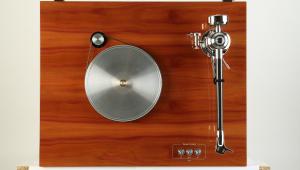Pro Ject 6 Perspex (£1000)
Some turntable manufacturers seem to make one model last for decades, but Pro-Ject is not so inhibited. Even without counting all eight colourways for the Debut III, the Austrian company’s website lists no fewer than 21 different turntable packages. The very latest of these is the Pro-Ject 6 PerspeX.
Visually, this is one of Pro-Ject’s happiest creations, certainly far more elegant than its earliest antecedent, the Pro-Ject 6, which I think was the brand’s first subchassis turntable. Now, the subchassis is a clean and simple shape, and the plinth is an eye-catching slab of clear acrylic, resembling the Pro-Ject 2 Xperience.
In the past, Pro-Ject’s ebullient founder Heinz Lichtenegger spent a lot of time experimenting with different materials and their different sonic signatures. ‘All materials have some effect,’ he says, ‘it’s a question of which pleases you more.’
Finding he preferred the character of an MDF platter to a metal one, Lichtenegger produced a turntable almost completely made of MDF, the RPM5. This was admittedly not the most accurate-sounding but, he says, ‘it grooves like crazy’. More recently, it seems to have been a case of finding combinations of materials that give a balanced result.
So, while some Pro-Ject models have acrylic platters, the 6 PerspeX uses one made of MDF, but with the refinement of a vinyl-playing surface. A lightweight screw-down record clamp is provided.
ARM EVOLUTION
Like the Pro-Ject 9cc tonearm (the one chosen by Linn for its Majik LP12 package), the 9cc Evolution supplied with the 6 PerspeX uses a carbon-fibre arm tube with integral headshell, while miniature ballraces replace the point-and-jewel-pad bearings of cheaper Pro-Ject arms. The obvious difference in the Evolution version is its more massive bearing housing.
For this review, we also received an Ortofon 2M Red moving-magnet cartridge, but the turntable can be expected to do justice to better cartridges than this.
I used the excellent Ortofon Kontrapunkt A moving-coil. Two alternative counterweights are supplied, for cartridges weighing 8–10g and 11–14g. With the 10g Kontrapunkt A, the lighter counterweight was too far back and fouled the turntable lid, while the heavier one was so far forward that its adjustment dial hit the arm’s bearing housing. In the end I just removed the plastic dial – no hardship if you own a stylus force gauge.
JUST LEFT AND RIGHT?
In the ‘Ballad of the Runaway Horse’ on Rob Wasserman’s Duets [GRP GRP 97 121] Jennifer Warnes sings ‘There is no space, just left and right,’ but fortunately, even with the 2M Red this wasn’t really true of the Pro-Ject deck. There was at least some depth to the image, although it didn’t stretch into the far distance as we know it can. Without the clamp, Wasserman’s impeccable bass playing was fairly well presented, if sounding a little light, and still with a tendency to a one-notey emphasis.
Adding the record clamp helped clear a slight confusion in the mid and gave the bass more punch, although it now tended to sound heavy and even pedestrian. I’m afraid at this point I preferred the softer, lighter and freer sound without the clamp.
However, with the Kontrapunkt A cartridge, the same music took on an extra dimensionality. The ambience on Warnes’ voice was no longer just a vague echo, it was now something that just might be the walls of a studio. Background vocals were more audible in their subtlety. Now, the sound with the clamp was definitely preferred, Wasserman’s bass at last gaining something like the elusive stringy quality of a real instrument. Turning to Dire Straits [Vertigo 9102 021] and ‘Sultans Of Swing’, I got a big warm sound, enjoyable though with a certain lack of clarity or transparency. You’d hardly expect a natural soundstage on this record, brilliantly produced to come over well on any transistor radio. But an exceptional hi-fi system will let you hear further into the way it’s been done, as I could when I switched, for comparison, to the Rega P9/Apheta.
On Rega’s own recording of Christine Collister [Love, ENS 002], the Pro-Ject provided tactile realism on the guitar parts, and even the more reticent background vocals were quite well conveyed, though the bass boomed a little. With Stevie Ray Vaughan’s ‘Tin Pan Alley’ [Pure Pleasure PPAN38734], though, I felt that the well-recorded but heavy bass became a little overpowering, if not actually losing control.
Orchestral music was well handled, I felt, as I listened to Barenboim’s Mozart Piano Concerto 21 with Barenboim/ECO [EMI ASD 2465]. There was a fair sense of space, if with only moderate depth, and the overall effect was quite smooth and pleasing if with some midrange boxiness.
PREJUDICE OVERCOME
In the end I liked this turntable more than I’d expected to, and it forced me to put aside some prejudices about its design approach. I still didn’t really like the clamp, which doesn’t do much to flatten down thin or slightly warped records, but I had to admit it usually improved the sound. On the other hand, I did like the well-made and effective lid, and could live with the relatively slight sonic degradation it produced.
VERDICT
One of the most attractive of the many and varied Pro-Ject players. Its unusual combination of semi-isolated subchassis, acrylic baseplate, heavy non-sealing lid and vinyl-faced MDF platter, held together (or apart) by generous amounts of rubbery Sorbothane, seems to produce an enjoyable and essentially vice-free sonic character, even if it lacks some precision and drive.
This review was originally published in the September 2009 issue



























































